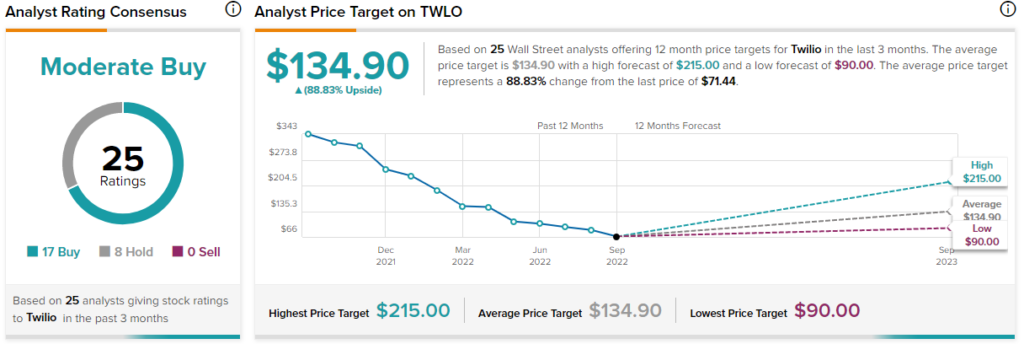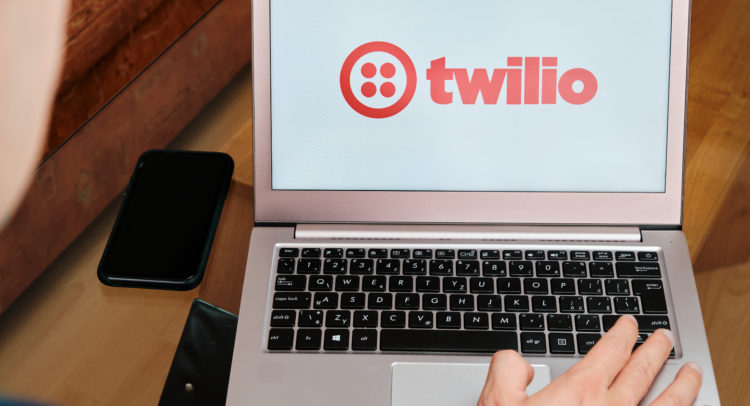It has been a volatile day for communications company Twilio (NYSE: TWLO). The company gained 1.1% in pre-market trading today but lost all those gains and has been red all day. Still, there was good news for Twilio. KeyBanc analyst Thomas Blakey started coverage on the company this morning. He pointed out that the company’s engagement strategy was likely to serve it well in terms of hiking gross margins. However, the overall bearishness of the market dragged TWLO down today.
Elevate Your Investing Strategy:
- Take advantage of TipRanks Premium at 50% off! Unlock powerful investing tools, advanced data, and expert analyst insights to help you invest with confidence.
Is Twilio’s enormous sell-off the beginning of the end for the company or an opportunity in the making? It’s not looking good for Twilio right now, especially when all the factors are taken into account. That’s why I’m bearish on Twilio right now. Its pandemic glory days are behind it, and what’s left doesn’t look all that appealing.
The last 12 months for Twilio shares have demonstrated a growth stock in stark decline. This time last year, Twilio was up around $337 a share. It even cleared $370 a share briefly, hitting its 52-week high.
That seemed to be the green flag for a massive sell-off that continued until this very day. Twilio shares lost roughly 80% of their value in that period, now hovering around $71 per share.
What is the Target Price for TWLO Stock?
Turning to Wall Street, Twilio has a Moderate Buy consensus rating. That’s based on 17 Buys and eight Holds assigned in the past three months. The average Twilio price target of $134.90 implies 88.8% upside potential.
Analyst price targets range from a low of $90 per share to a high of $215 per share.

Investor Sentiment Suggests a Potential Comeback
Twilio may have had a rough year, but not everyone is counting it out just yet. Currently, Twilio has a Smart Score of 7 out of 10 on TipRanks. That’s the highest level of “neutral.” Further, that suggests that the company has a slightly better-than-even chance of outperforming the broader market.
However, it’s a bit more of a mixed picture in insider trading. Insider trading at Twilio has been brisk, but all transactions are “uninformative.” Thus, we’re left to look at the aggregate activity, and that’s been moving quite a bit.

In the last three months, there were nine Buy transactions staged and 11 Sell transactions. Stretching back to the last 12 months, we have 49 Buys and 61 Sells. Looking at how the Buys and Sells are distributed, the selling has been coming in routinely throughout the year.
However, the Buy transactions seem to come in bursts. Based on the previously-seen pattern, when the August data becomes available, there might be another burst, as the Buy numbers seem to spike every three months.
A Multi-Elephant Affair that Spells Trouble for Twilio
Let’s start with the elephant in the room – or at least one of them. Twilio stock has been plunging for the last year, and that’s likely not going to strike potential investors as a good sign. Of course, it’s worth considering just why the stock is on the decline.
Twilio was something of a pandemic darling, seeing its biggest growth in the period after the pandemic started. From April 2020 to February 2021, Twilio stock’s value jumped almost six-fold, going from around $80 to around $450.
The plunge that followed, therefore, wasn’t the sign of a company on its deathbed but rather that of a pandemic darling finding its natural equilibrium. The chart over the last year shows a long plunge, but over the last three years, it’s Twilio going back to about where it was in January 2020.
However, this is a multi-elephant affair. There’s one more elephant in the room that can’t be so handily explained: the hacking. Hackers targeted login credentials and two-factor authentication codes and managed to get them from 125 different customers and businesses.
Social engineering hacks allowed hackers to send messages that claimed to be from Twilio itself, which fooled the targets sufficiently into handing over such materials.
That won’t help Twilio, going forward. A lack of reliability and security will hurt its public perception. However, that “engagement strategy” that Thomas Blakey mentioned might turn things around. One part of that is an increasing focus on “emotional connections.” The new “building blocks of customer experience,” as a Twilio study found, are “efficiency, expertise, and emotion.”
That might sound a bit too pie-in-the-sky to be useful, but there is a certain mechanic here that could be worthwhile. Why focus on hacks when instead, you can focus on how happy you feel to be emotionally connected to a business or a person? Twilio can help provide that connection, so some might be willing to overlook the hacking or the potential for more hacking later on.
At least, that’s the hope. Twilio certainly needs this to work, especially in light of its spending habits. The company already pays out hefty fees to network service providers. That’s hurting margins pretty badly, and it also demonstrates the need to get more users in the fold. More users mean more backs on which to support fees. That should give margins a boost too.
Plus, Twilio is spending substantial sums on research and development operations. That’s pretty necessary spending to avoid a death spiral of outdated technology. However, that spending needs to result in profitability fairly soon, or it’s just not sustainable. Worse, Twilio’s cost to obtain new customers won’t give it a lot of help in the short term, and potentially not ever.
Back in the second quarter, Twilio brought in $943 million in revenue. The problem was that the company ultimately posted a net loss of $323 million. In a time when investors want to see profitability in their stocks, that’s not going to serve as a buy-in bell-ringer either.
Conclusion: TWLO is Holed Below the Waterline
There’s a lot of bad news facing Twilio right now. Hacked companies tend to suffer. The costs of a data breach are enormous. Back in 2020, one study found that one in four Americans refused to do business with a company that suffered a data breach. Twilio needs new customers, and it needs those customers to be profitable too.
Considering everything Twilio’s facing, that’s not likely to happen. Granted, the company has a huge potential upside and a terrific buy-in point. Still, right now, it doesn’t look like there’s much worth buying in on. The end result is bad news for investors, and that’s why I’m bearish on Twilio.
















